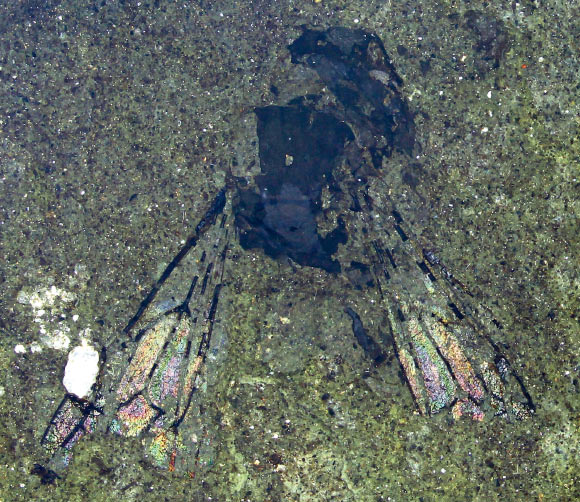Paleontologists have described a unutilized species of the extant bee genus Leioproctus from a fossil specimen present in southern Untouched Zealand.

Leioproctus barrydonovani, habitus of phase. Scale bar – 1 mm. Symbol credit score: M.S. Engel & U. Kaulfuss, doi: 10.5252/zoosystema2025v47a3.
Named Leioproctus barrydonovani, the unutilized species lived all through the Center Miocene epoch, some 14.6 million years in the past.
The traditional insect belongs to Leioproctus, a immense genus throughout the plasterer bee community Colletidae.
Extant Leioproctus species are petite, unlit, bushy bees between 4 and 16 mm in field.
They’re present in Australasia and South The usa, and come with probably the most ordinary local bees in Untouched Zealand.
“The biota of New Zealand is a mosaic of ancient lineages interspersed among arrays of relative newcomers that have diversified since the Oligocene-Miocene,” mentioned Dr. Michael Engel from the American Museum of Herbal Historical past and Dr. Uwe Kaulfuss from the Georg-August-Universität Göttingen.
“Indeed, in many respects the fauna is typical of an island biota, reflective of lineages dispersing to the landmass at various times since its breakup from Gondwana c. 80 million years ago and then speciating.”
“Some insect lineages have clearly thrived and evolved unique features within New Zealand, but many are conspicuously and enigmatically depauperate given the complexity and scale of the landscape, seemingly reflecting their late arrival to the islands,” they added.
“Indeed, some prominent and complex biological interactions are poorly represented within the modern New Zealand fauna such as specialized insect pollinators, which are few in New Zealand and generalist flies are the dominant pollinators.”
“In fact, although bees are the preeminent pollinators worldwide, their diversity in New Zealand is meagre, with only 42 species of which a mere 28 are endemic.”
“This has led to a perception that bees are comparative newcomers to New Zealand and in the absence of any fossil record it has been challenging to determine the antiquity of the melittofauna.”

Leioproctus barrydonovani, habitus of counterpart. Scale bar – 1 mm. Symbol credit score: M.S. Engel & U. Kaulfuss, doi: 10.5252/zoosystema2025v47a3.
Leioproctus barrydonovani is represented via an impact of a just about whole bee in dorsal view.
The specimen (overall field of the frame is 6.4 mm) was once recovered from the Center Miocene deposits of the Hindon Maar in Otago, southern Untouched Zealand.
“The single specimen is a compressed, articulated fossil bee preserved as part and counterpart in dark gray organic mudstone,” the paleontologists mentioned.
The presence of Leioproctus barrydonovani within the Center Miocene fauna of Untouched Zealand poses some attention-grabbing concepts in regards to the bee fauna of those islands.
“If the genus had invaded New Zealand before 14.6 million years ago, then it should have been sufficient time for the group to have more extensively diversified or to develop floral specializations with the endemic flora,” the researchers mentioned.
“The reality is, however, that there are merely 18 species of endemic Leioproctus, indicating that either there was a diversification that was subsequently winnowed considerably through extinction and driven by factors unknown, that some complex biotic processes or interactions prevented the lineage from more extensive speciation, or that the modern Leioproctus of New Zealand are unrelated to the fossil, at least subgenerically, and represent one or more later reintroductions between the mid-Miocene and Pleistocene.”
“In fact, there are currently no data to indicate that the three groups of Leioproctus in New Zealand form a monophyletic group, and they themselves could represent multiple, younger invasions of the islands.”
“If the fossil is representative of an early invasion of Leioproctus into New Zealand during or before the Middle Miocene, then one would hypothesize that a greater number of species would have developed across the complex landscape and climates of the islands.”
Leioproctus barrydonovani inhabited broadleaf woodlands and can have visited vegetation of the genus Pseudopanax, nowadays ordinary all through Untouched Zealand.
“At least one extant species, Leioproctus pango, is known to collect pollen from flowers of Pseudopanax, a genus of small trees and shrubs common throughout New Zealand,” the scientists mentioned.
“Among 48 fossilized flowers collected at the Hindon Maar Complex all but two are Araliaceae flowers of an undescribed species of Pseudopanax.”
“Although there is no direct evidence of the host plant(s) of Leioproctus barrydonovani (no pollen was found attached to the fossil), the abundance of flowers of Pseudopanax in the same deposit might indicate that this Miocene bee species visited Pseudopanax sp., probably among other plants.”
“Given the fine detail of preservation, the potential to recover in situ pollen is great should additional and more complete bees be uncovered in future excavations.”
“Direct evidence of such floral associations has been recorded from other important Lagerstätten, and the Hindon Maar Complex and nearby Foulden Maar have considerable potential for glimpses into insect-plant interactions during the Miocene of Zealandia.”
The invention of Leioproctus barrydonovani is reported in a paper within the magazine Zoosystema.
_____
M.S. Engel & U. Kaulfuss. 2025. A bee from the center Miocene Hindon Maar of southern Untouched Zealand (Hymenoptera, Colletidae). Zoosystema 47 (3): 43-49; doi: 10.5252/zoosystema2025v47a3

